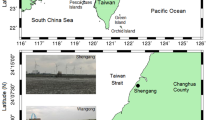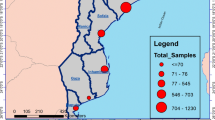Abstract
So far, there have been no studies on the distribution of viral white spot syndrome in wild Indian white shrimp (Fenneropenaeus indicus) brooders at Iranian capture sites. This study was conducted to investigate the presence of white spot syndrome virus (WSSV) in wild Indian white shrimps in Iran, using PCR, histopathologic, and electron microscopic surveys. The samples were collected within two seasons (autumn and spring) and from two provinces (six capture sites), from the major hatcheries providing spawners. Eight hundred thirty-three samples were collected and analyzed first by PCR, after which the positive samples were examined using histological tests, and if inclusion bodies were observed, electron microscopy was also used. White spot syndrome virus was detected only at the capture sites in Sistan and Baluchistan Province, where the mean infection rate was significantly higher in the spring (8.7%) than in the autumn (2.03%). At the Chabahar, Pasabandar, and Govater capture sites, the mean infection rate was significantly higher (4.9%, 2.1%, and 9.2%, respectively), than in Hormozgan Province. The results showed that there was no significant difference in infection rate between the two different sizes and sexes of shrimps (P < 0.05). Phylogeny analysis revealed a close relationship between the viruses from this study and those in other Asian countries, including China, India, Bangladesh, Thailand, Taiwan, and South Korea. It is possible that the virus has spread across the Indian Ocean to other countries. Therefore, the spawners in this study, particularly those collected during the spring and those from capture sites in Sistan and Baluchistan Province, were found to be more susceptible to WSSV infection, and the virus might have been transmitted vertically from WSSV-infected brooders to post-larvae.





Similar content being viewed by others
References
Afsharnasab M, Dashtiannasab A, Yeganeh V (2007) Assessing pathogenesis of the white spot syndrome virus (wssv) in the whiteleged shrimp (litopenaeus vannamei). Iran Sci Fish J 16:1–8
Afsharnasab M, Kakoolaki S, Afazli F (2014) The status of white spot syndrome virus (wssv) in islamic republic of iran. Iran J Fish Sci 13:1021–1055
Afsharnasab M, Rezvani S, Lalouei F (2005) Identification of white spot syndrome disease (wssd) in penaeus indicus by polymerase chain reaction (pcr) method. Iran Sci Fish J 14:1–12
Durand S, Lightner D (2002) Quantitative real time pcr for the measurement of white spot syndrome virus in shrimp. J Fish Dis 25:381–389
Flegel T (2006) Detection of major penaeid shrimp viruses in asia, a historical perspective with emphasis on thailand. Aquaculture 258:1–33
Granja CB, Vidal OM, Parra G, Salazar M (2006) Hyperthermia reduces viral load of white spot syndrome virus in penaeus vannamei. Dis Aquat Org 68:175–180
Hossain MS, Otta S, Chakraborty A, Kumar HS, Karunasagar I, Karunasagar I (2004) Detection of wssv in cultured shrimps, captured brooders, shrimp postlarvae and water samples in bangladesh by pcr using different primers. Aquaculture 237:59–71
Jian X-f, Lu L, Chen Y-g, Chan S-M, He J-g (2005) Comparison of a novel in situ polymerase chain reaction (ispcr) method to other methods for white spot syndrome virus (wssv) detection in penaeus vannamei. Dis Aquat Org 67:171–176
Kiatpathomchai W, Boonsaeng V, Tassanakajon A, Wongteerasupaya C, Jitrapakdee S, Panyim S (2001) A non-stop, single-tube, semi-nested pcr technique for grading the severity of white spot syndrome virus infections in penaeus monodon. Dis Aquat Org 47:235–239
Kumar S, Nei M, Dudley J, Tamura K (2008) MEGA: a biologist-centric software for evolutionary analysis of DNA and protein sequences. Brief Bioinform 9(4):299–306
Larkin MA, Blackshields G, Brown NP, Chenna R, McGettigan PA, McWilliam H, Valentin F, Wallace IM, Wilm A, Lopez R (2007) Clustal W and Clustal X version 2.0. Bioinformatics 23(21):2947–2948
Leobert D, Lavilla-Pitogo CR, Villar CBR, Paner MG, Sombito CD, Capulos GC (2007) Prevalence of white spot syndrome virus (wssv) in wild shrimp penaeus monodon in the philippines. Dis Aquat Org 77:175–179
Lightner D, Redman R, Pantoja C, Tang K, Noble B, Schofield P, Mohney L, Nunan L, Navarro S (2012) Historic emergence, impact and current status of shrimp pathogens in the Americas. J Invertebr Pathol 110:174–183
Lightner DV (1996) A handbook of shrimp pathology and diagnostic procedures for diseases of cultured penaeid shrimp. World Aquaculture Society, Baton Rouge
Lightner DV, Redman RM (1998) Shrimp diseases and current diagnostic methods. Aquaculture 164:201–220
Lo C-F, Ho C-H, Chen C-H, Liu K, Chiu Y, Yeh P, Peng S, Hsu H, Liu H, Chang C (1997) Detection and tissue tropism of white spot syndrome baculovirus (wsbv) in captured brooders of penaeus monodon with a special emphasis on reproductive organs. Dis Aquat Org 30:53–72
Lo C-F, Peng S-E, Kou G-H (1998) PCR screening for white spot syndrome virus (wssv) in penaeus monodon brooders: a general effort to combat shrimp wss. In: Aquaculture and fisheries management. Conference proceedings. Taiwan Fisheries Research Institute, pp 63–72
Lo CF, Leu J-H, Ho CH, Chen CH, Peng SE, Chen YT, Chou CM, Yeh PY, Huang CJ, Chou HY (1996) Detection of baculovirus associated with white spot syndrome (wsbv) in penaeid shrimps using polymerase chain reaction. Dis Aquat Org 25:133–141
Mohan C, Sudha P, Shankar K, Hegde A (1997) Vertical transmission of white spot baculovirus in shrimps: a possibility? Curr Sci 73:109–110
Momoyama K, Hiraoka M, Nakano H, Koube H, Inouye K, Oseko N (1994) Mass mortalities of cultured kuruma shrimp, penaeus japonicus, in japan in 1993: histopathological study. Fish Pathol 29:141–148
Otta S, Shubha G, Joseph B, Chakraborty A, Karunasagar I, Karunasagar I (1999) Polymerase chain reaction (pcr) detection of white spot syndrome virus (wssv) in cultured and wild crustaceans in India. Dis Aquat Org 38:67–70
Peng S-E, Lo C-F, Lin S-C, Chen L-L, Chang Y-S, Liu K-F, Su M-S, Kou G-H (2001) Performance of wssv-infected and wssv-negative penaeus monodon postlarvae in culture ponds. Dis Aquat Org 46:165–172
Saberi A, Bandehpour M, Afsharnasab M, Ghayour E, Namin SY, Kazemi B (2008) Designing and introduce a diagnostic kit for detection of white spot syndrome virus in cultured Penaeus indicus in Iran. Pak J Biol Sci 11:2660–2664
Siddique MA, Haque MI, Sanyal SK, Hossain A, Nandi SP, Alam A, Sultana M, Hasan M, Hossain MA (2018) Circulatory white spot syndrome virus in South-West region of Bangladesh from 2014 to 2017: molecular characterization and genetic variation. AMB Express 8(1):25
Tang KF, Lightner DV (2000) Quantification of white spot syndrome virus DNA through a competitive polymerase chain reaction. Aquaculture 189:11–21
Tang KF, Pantoja CR, Redman RM, Lightner DV (2013) A histological variant of white spot syndrome virus (wssv) from the Kingdom of Saudi Arabia. J Invertebr Pathol 113:82–85
Tapay LM, Nadala ECB Jr, Loh PC (1999) A polymerase chain reaction protocol for the detection of various geographical isolates of white spot virus. J Virol Methods 82:39–43
Venegas C, Nonaka L, Mushiake K, Nishizawa T, Muroga K (2000) Quasi-immune response of penaeus japonicus to penaeid rod-shaped DNA virus (prdv). Dis Aquat Org 42:83–89
Vidal OM, Granja CB, Aranguren F, Brock JA, Salazar M (2001) A profound effect of hyperthermia on survival of litopenaeus vannamei juveniles infected with white spot syndrome virus. J World Aquacult Soc 32:364–372
Wang C-H, Lo C-F, Leu J-H, Chou C-M, Yeh P-Y, Chou H-Y, Tung M-C, Chang C-F, Su M-S, Kou G-H (1995) Purification and genomic analysis of baculovirus associated with white spot syndrome (wsbv) of penaeus monodon. Dis Aquat Org 23:239–242
Wang Y, Hassan M, Shariff M, Zamri S, Chen X (1999) Histopathology and cytopathology of white spot syndrome virus (wssv) in cultured Penaeus monodon from peninsular Malaysia with emphasis on pathogenesis and the mechanism of white spot formation. Dis Aquat Org 39:1–11
Withyachumnarnkul B, Boonsaeng V, Chomsoong R, Flegel TW, Muangsin S, Nash GL (2003) Seasonal variation in white spot syndrome virus-positive samples in broodstock and post-larvae of Penaeus monodon in Thailand. Dis Aquat Org 53:167–171
Witteveldt J, Cifuentes CC, Vlak JM, van Hulten MC (2004) Protection of Penaeus monodon against white spot syndrome virus by oral vaccination. J Virol 78:2057–2061
Acknowledgements
The authors would like to thank Shiraz University, the Hormozgan Veterinary Organization, and the Hormozgan and Bushehr Fishery Organization for their financial support of this study.
Author information
Authors and Affiliations
Corresponding author
Additional information
Handling Editor: Tim Skern.
Publisher's Note
Springer Nature remains neutral with regard to jurisdictional claims in published maps and institutional affiliations.
Rights and permissions
About this article
Cite this article
Gholamhosseini, A., Mohammadi, A., Akbari, S. et al. Molecular, histopathologic and electron microscopic analysis of white spot syndrome virus in wild shrimp (Fenneropenaeus indicus) in the coastal waters of Iran. Arch Virol 165, 1433–1440 (2020). https://doi.org/10.1007/s00705-020-04625-3
Received:
Accepted:
Published:
Issue Date:
DOI: https://doi.org/10.1007/s00705-020-04625-3




